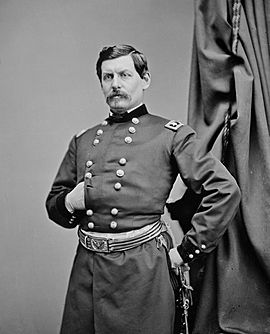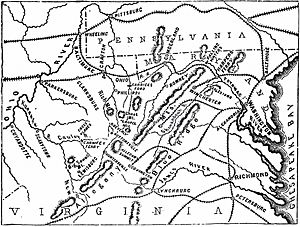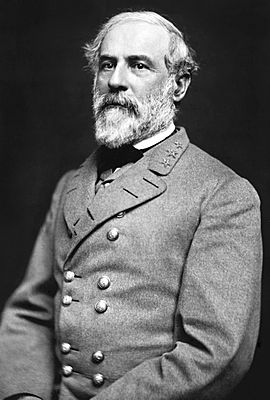Western Virginia campaign facts for kids
Quick facts for kids Western Virginia campaign |
|||||||
|---|---|---|---|---|---|---|---|
| Part of the American Civil War | |||||||
|
|||||||
| Belligerents | |||||||
| Commanders and leaders | |||||||
| George B. McClellan Thomas M. Harris Isaac Duval William S. Rosecrans |
Robert E. Lee Robert S. Garnett † |
||||||
The Western Virginia campaign was a series of important military actions. It happened from May to December 1861 during the American Civil War. Union forces, led by Major General George B. McClellan, moved into the western part of Virginia. Their goal was to stop the Confederate army from taking control of this area. This region later became the state of West Virginia.
People from western Virginia fought on both sides during this campaign. A group of Union supporters in Wheeling chose Francis H. Pierpont as their governor. They also worked to create a new state in western Virginia. Over time, large Confederate forces left the region. Only small local groups stayed to hold onto the southern and eastern parts for most of the war.
Western Virginia was very important because it had many minerals. The Confederates needed these minerals to make weapons and ammunition. The area also had roads and turnpikes. These paths would let the Union army reach Tennessee, North Carolina, and the Shenandoah Valley. Plus, the Baltimore and Ohio Railroad in the north connected the eastern Union states to the Midwest.
Contents
Why the Western Virginia Campaign Happened
In April 1861, a special meeting in Virginia decided to leave the United States. They voted to join the Confederacy. But many people in the western counties of Virginia did not agree with this decision. These western counties felt more connected to states like Pennsylvania and Ohio than to eastern Virginia.
After the vote, a Union leader named John Carlile called a meeting in Clarksburg. They decided to have another meeting in Wheeling. This meeting would figure out what the people of northwest Virginia should do.
The Union army quickly formed two infantry regiments from West Virginia. These groups fought in the first battle of the campaign at Philippi. To get Union forces organized, George B. McClellan became the commander of the Department of the Ohio. This area included Ohio, Indiana, Illinois, western Pennsylvania, and western Virginia. He gathered soldiers from these states and moved into Virginia in early May. They followed the Baltimore and Ohio Railroad and the Kanawha River. Throughout the war, West Virginia raised many soldiers to fight for the Union.
The Confederates also appointed commanders in western Virginia. Colonel George A. Porterfield was in the northwest. Brigadier Generals John B. Floyd and Henry A. Wise were in the Kanawha Valley. This divided leadership made it hard for the Confederates to work together. Also, General Robert E. Lee, who led Virginia's military, did not realize how strong Union support was in western Virginia.
Key Battles of the Campaign
Many battles took place during the Western Virginia campaign. Each one was a step in deciding who would control this important area.
Philippi Battle
Confederate Colonel Porterfield gathered about 775 new soldiers at Philippi in May. On June 3, a Union group led by Brigadier General Thomas A. Morris attacked the Confederate camp. The Confederates fired only once and then quickly ran away from the town. Only a few soldiers were hurt on each side.
Rich Mountain and Laurel Hill Battles
Confederate Brigadier General Robert S. Garnett had a small force near Laurel Hill and Rich Mountain. McClellan sent a small group that went around the Confederate left side on Rich Mountain. This move forced the main Confederate force at Laurel Mountain to retreat.
Corrick's Ford Battle
As the Confederates retreated from Rich Mountain, Garnett sent a small group to a ford at the Cheat River. They were meant to slow down the Union chase. But Garnett was killed by Union gunfire. He was the first general officer from either side to die in the war. The Confederate group then quickly ran away.
Scary Creek Battle
Union soldiers, led by Colonel John Lowe, moved up the Kanawha Valley. They found a Confederate camp near Scary. The Confederates were led by Colonel George S. Patton Sr.. The 21st Ohio Infantry Regiment charged with bayonets but were pushed back. They had many injuries. The Union forces retreated, and the Confederates won a small but important victory.
Kessler's Cross Lanes Battle
The Confederate group led by Floyd attacked a Union regiment. This Union group was led by Colonel Erastus B. Tyler at Kessler's Cross Lanes. The Confederates won, which helped them control the eastern Kanawha Valley for a short time.
Carnifex Ferry Battle
Brigadier General William S. Rosecrans took three groups of soldiers from Clarksburg. They attacked Floyd's group at Carnifex Ferry. The Confederates managed to stop the Union attacks. But they were outnumbered and had to retreat that night.
Cheat Mountain Battle
During the summer, the Union army focused on protecting the main roads through western Virginia. Brigadier General Joseph J. Reynolds commanded the Union soldiers on Cheat Mountain. Their job was to protect the Staunton and Parkersburg Turnpike. Lee tried to drive these Union forces off the mountain. He had a complex plan to surround the Union soldiers. However, one of his commanders backed out at the last minute. This forced Lee to cancel the attack.
Greenbrier River Battle
Union Brigadier General Reynolds attacked the camps of Henry R. Jackson's Confederate group. But the Union forces were pushed back. After a heavy artillery attack, Reynolds went back to Cheat Mountain.
Camp Allegheny Battle
Union Brigadier General Robert H. Milroy attacked Camp Allegheny. This was where Colonel Edward Johnson's main Confederate force in western Virginia was located. The Union soldiers were pushed back.
What Happened After the Campaign
The Union army stayed in control of western Virginia for the rest of the war. There were some Confederate raids into the area, but the Union held on. Western Virginia was later separated from the Department of the Ohio. It became a new military area called the Department of Western Virginia.
The Wheeling convention quickly set up the Restored Government of Virginia. This Union-supporting government claimed to be the real government for all of Virginia. They said Richmond was their capital. But in reality, they only controlled the parts of the state held by Union forces. This arrangement lasted until 1863. That's when western Virginia officially became the state of West Virginia. After West Virginia became a state, the Restored Government moved to Alexandria. It stayed there for the rest of the war.
Because of his wins in western Virginia, McClellan became very famous in the North. Newspapers called him the "Young Napoleon." After the Union lost the First Battle of Bull Run, he was given command of the Army of the Potomac.
Lee was criticized a lot in the newspapers for his losses in western Virginia. Soldiers and the press called him "Granny Lee" and "Evacuating Lee." He was then sent to South Carolina to help build defenses along the coast. The remaining Confederate forces in western Virginia were organized into the Confederate Army of the Northwest. Later, this army became part of the Valley District of the Army of Northern Virginia.




